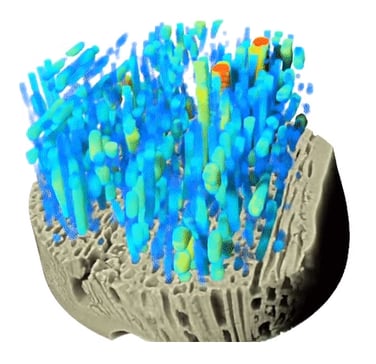How High-Speed Micro-CT Unlocks Both High Throughput and Dynamic 4D Imaging
 Fast micro-CT scanning or high temporal resolution has been an important part of the TESCAN micro-CT DNA for years, but what benefit does this offer you as a micro-CT user? This question is answered by two recently published open-access papers, one by Evelien Zwanenburg at Warwick University (UK) and one by Simo Mäkiharju at the University of Berkeley (USA). Two papers about scan speed, serving two different purposes.
Fast micro-CT scanning or high temporal resolution has been an important part of the TESCAN micro-CT DNA for years, but what benefit does this offer you as a micro-CT user? This question is answered by two recently published open-access papers, one by Evelien Zwanenburg at Warwick University (UK) and one by Simo Mäkiharju at the University of Berkeley (USA). Two papers about scan speed, serving two different purposes.
Evelien Zwanenburg’s paper is a very complete and comprehensive review of high-speed imaging with lab-based computed tomography. She expertly explains the benefits and use cases of fast X-ray imaging. Simplified, one could say that speed can either be leveraged to achieve a high sample throughput, or to perform fast in-situ experiments―almost bringing synchrotron capabilities into your lab.
The paper shows how time-resolved CT experiments evolved from being the almost exclusive realm of synchrotron facilities to a more balanced distribution between lab and synchrotron. Also, figures show how TESCAN is pioneering this area of very fast, high-throughput and dynamic micro-CT both in absolute scan time and in the number of publications on fast scanning. The full article can be read in the November 2021 issue of Measurement Science and Technology.
The paper of Simo Mäkiharju, on the other hand, shows a very concrete example of an application that could only be solved using dynamic micro-CT at high temporal resolution. The publication tackles the study of multiphase flow, in cases where the flow behaviour cannot be studied using traditional visible light particle image velocimetry, due to the opaque nature of the multiphase flow. In this experiment, a complex in-situ device including a flow pump was placed on the rotation stage of the TESCAN CoreTOM to image suspended silver-coated particles in a glycol solution. A flow was applied, and the setup was imaged at an incredible 2.9 seconds per scan. This resulted in an output of 200 full 3D tomograms, acquired in less than 10 minutes.
The work was done in conjunction with Math2Market Gmbh, whose software GeoDict was able to track all individual particles, reconstruct their trajectories and calculate flow fields in the setup. It shows the huge potential of fast 4D imaging when combined with powerful analytical software, capable of handling large amounts of data, both in volume and in number of datasets. Finally, the paper highlights the diversity of applications for dynamic CT in opaque flow, also showing examples of bubble analysis and pore clogging of flow inside a porous medium. TESCAN micro-CT enables us to highlight it to GeoDict users looking for an in-depth investigation of flow dynamics in porous materials with increased fidelity and accuracy through its unique tracking of the particles in the flow. The full paper is available in the latest issue of Experiments in Fluids.
Have the two papers inspired you or raised curiosity about fast x-ray imaging – either for high-throughput or dynamic CT experiments? Have a look at our website or contact your local TESCAN representative!

Wesley De Boever
Product marketing Manager for TESCAN micro-CT
